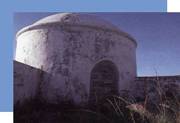|
History of the
Fortresses
One of the most enduring reminders of Portugal's age of
exploration is the number of ruined forts that can be found in
coastal areas of Africa, Arabia, India, Malaya and Indonesia. They
were designed to protect Portuguese settlements against pirates,
hostile natives and European rivals, as well as sheltering people
from neighboring areas who looked for protection.
When the Portuguese settled in Macau in 1554-57, they didn't
initially need such protection. Their well armed ships kept local
pirates at bay, the neighboring Chinese were happy to have them as
entrepreneurs for their overseas trade, and it was many years before
the rest of Europe discovered Portugal's jealously guarded secret -
that China was the vast, rich Cathay described by Marco Polo.
Not until the last years of the 16th century did the
Dutch arrive in Asia, hoping to capture trade and strategic ports
from the Portuguese, with a fleet of the biggest and best-armed
ships of the day.
In response, Macau began building fortifications, while assuring
the Mandarins that they were solely for defense against the newly
arrived barbarians, not the Chinese.
The forts were placed along the Praia Grande, in the Inner
Harbour and on the city's highest hills.
 Except for the praia-side Bomparto, the forts were only
half completed when the Dutch invaded on June 24, 1622, but they
were instrumental in driving the Dutch back to sea. In the following
year, Dom Francisco de Mascarenhas arrived to be the first full-time
governor. His prime aim was to complete the forts and make Macau
impregnable to invasion. Except for the praia-side Bomparto, the forts were only
half completed when the Dutch invaded on June 24, 1622, but they
were instrumental in driving the Dutch back to sea. In the following
year, Dom Francisco de Mascarenhas arrived to be the first full-time
governor. His prime aim was to complete the forts and make Macau
impregnable to invasion.
Under his administration the forts
of Monte, Barra, S. Francisco, Penha and S. Januario were finished
and Guia planned. Two systems of city walls were constructed: one in
the north connected the Inner Harbour at Patane to monte and on to
the south east, joining the Fortress of S. Januario to end at S.
Francisco; one in the south began a Bomparto, lead up to Penha and
down to the Harbour.
Mascarenhas also established a cannon foundry and invited Manuel
Tavares Bocarro to run it. Bocarro's cannons became famous
throughout Asia, for their beauty as well as efficiency. They were
used by China's last Ming emperors and various kings of Siam as well
as the Portuguese.
Guia fort was built in 1637, and then followed two centuries
without new forts, as Macau lost its importance for predators. The
situation changed following the Anglo Chinese War in 1841. The
Mandarins demanded that Macau pull down some of its walls. Instead
the Portuguese built new forts on Mong-Ha and Dona Maria hills,
facing the Chinese border, and on the islands of Taipa in 1847 and
Coloane in 1884.
In the 1870's the government, desperate sold most of the Bocarro
cannons for scrap metal, ( a few remain, in the Tower of London and
Jakarta Museum ), the forts fell into decay, while the wall was
gradually demolished to make way for a growing city.
Today the walls are all gone but several forts survive, now
converted for peaceful, public use, as described in this page. (For
more detailed descriptions, see Jorge Graça's [The Fortification of
Macau], and [Chronicles in Stone] by Shann Davies, available from
the Macau Government Tourist Office).
Construction and Design
The forts give parts of Macau an old European skyline, which
isn't surprising as they follow the design of Vauban, Louis XIV's
chief military engineer. His idea was to offer the lowest possible
profile to attackers while providing the widest field of fire for
the defenders. So the forts have walls that slant slightly upwards,
against earthen ramparts. Bastions at corners of the walls were
meant to break up an attack, while casemates contained gun
emplacements.
As with forts in Europe, those in Macau stood oil stone
foundations, but many of the walls differed considerably. They were
made of chunambo, a mixture of earth, straw, lime and oyster shells,
tightly packed in layers between strips of wood. This material was
said to be able to withstand cannonballs. This is never tested in
Macau , however, when part of the wall, built of chunambo was
demolished it took 1,800 lbs. of gunpowder to destroy 142 yards of
it.
Another characteristic of Macau's forts is that they frequently
contained hermitages, which were places of pilgrimage especially for
sailors and traders who welcomed the sight of the hilltop forts on
return from dangerous voyages.
In addition to strategic hilltop locations, the forts were built
to protect the Inner Harbour, the Praia Grande bay and to a lesser
extent, the Outer Harbour and the Chinese border. From the vantage
point of Guia fort, a visitor today can easily visualise how
effectively the forts covered all approaches to Macau.
| 